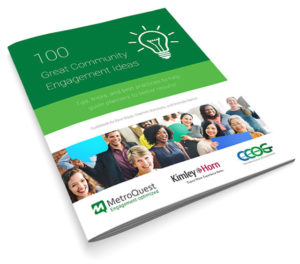How to Develop an Effective Public Engagement Plan

This blog was originally published on August 4, 2015.
Developing a Public Engagement Plan
In order to run a successful public engagement campaign, you must develop a comprehensive and strategic plan! This plan will be the blueprint for success for your team, so make sure that you sit down and think strategically as early as possible.
To help you get started, we’ve created a short outline for crafting a public engagement plan that drives great results. Let’s begin…
1. Define the Scope of Your Project
Start by defining the scope of the project with your team. You can do this by asking guiding questions such as: why are we doing this, what decisions will be made at the end of the project, who will be affected, what role will stakeholders play in the decision-making process, what is the project timeline, what level of participation are we hoping to achieve?
Answering and getting internal agreement on these questions will set a clear purpose and help align your team and guide you throughout the engagement process.
2. Know Your Limitations
Be clear about what you understand the limitations of the project to be. Common limitations include time, finances, available resources and legislative or jurisdictional barriers. Make sure your team understands why these limitations exist and can provide accurate and consistent information to the public if asked.
3. Identify Key Stakeholders

Who will be affected by the decisions you make? Take time to identify all of the people who are interested in the project, people who will benefit from the project and people who will be negatively impacted. These are the people the public engagement plan will need to target.
Common stakeholders include individuals in specific geographic areas, community groups, business associations, special interest organizations, all levels of government, schools, major employers, and so on!
Consider the interests of each identified stakeholder and how your project will impact them. Each group will have key issues, interest and priorities, and a good understanding of them will assist you in the development of your online engagement strategy and the promotional material you choose to engage with each audience.
4. Establish Specific Objectives
Start at the end and work backwards. What is the best possible outcome? What are your objectives for the public involvement process? What kinds of data will you need to make key decisions?
Keep in mind that a successful engagement process doesn’t mean the highest amount of public input. Quality of feedback is crucial, as is the breadth of participation that you receive. For example, it might be more important for you to hear from members of a particular rural community than simply the maximum number of people possible.
5. Choose Metrics and Targets

Based on the objectives you identify, create quantifiable metrics that you can use to monitor the engagement process. These metrics should be simple, easily tracked and tied directly to your objectives. For instance, you may track the number of participants you engage with, the level of demographic and geographic diversity you achieve, or the number of data points you collect (votes on alternatives, comments, map markers, etc.).
6. Create Your Timeline with Milestones
It’s now time to lay out a timeline. An effective online engagement plan should have milestones and dates tied into your project metrics. Consider project phases, time required to build public awareness and participation for key audiences, data processing time and deliverables needed for post-project reporting. Try using a Gantt chart to keep track and process all of your important milestones!
7. Choose Your Channels
Provide multiple outlets for people to participate and provide input on your planning project! Make sure you accommodate for people without access to a web or mobile device. This can be done by providing kiosks at community centers, tablets at special community events, or paper-based input options, for example.
To learn about the leading online tools that have helped planners achieve their best public engagement results, check out our webinar: Essential Online Public Engagement Toolbox for Planning.
8. Craft a Strong Promotional Strategy

As most public participation professionals know, it can be difficult to capture the attention of the community. In order to successfully engage the public, you’ll have to create a strong promotional strategy.
Learn how to promote your public participation online in our blog: 10 Tips on How to Promote Public Participation.
9. Allow for Flexibility Throughout the Process
Make sure you leave some flexibility, time and resources to alter your plan midstream. Monitor engagement results early on and be prepared to adjust your strategies to fill in any demographic gaps. Don’t plan all events and activities and commit all of your budget in advance. Anticipate the need for “boots on the ground” or other promotional efforts to reach specific groups in your community.
10. Develop a Post-Engagement Plan
Think about how you will report back to the public on the results of your engagement process before you begin, to help guide your choice of questions and other elements of the engagement process. When your engagement process is over, and you have collected a large amount of high-quality data to support your project, you’ll be prepared to analyze the results and create insightful reports for the project team, proponents and the community.
Remember that you have two very different audiences for reporting: internal and external groups. For internal purposes, an in-depth report is likely required. For external audiences, creating easy-to-digest infographics and shorter summaries will allow the general public to see the results of the engagement process without wading through 50 pages of detailed text.
Overall, a complete and strategic public engagement plan will make all components of your project run more effectively and smoothly and help guide your team to engagement success!
Interested in learning more about great public engagement? Download our FREE eBook for 100 community engagement ideas shared by 150+ planners!
eBook | 100 Great Community Engagement Ideas
Explore the best engagement ideas shared by 150+ planners at APA’s National Planning Conference. You’ll get 100 tips for better community engagement.
